ATMC ICT700: System Analysis and Design Report for OZES CRM
VerifiedAdded on 2023/03/30
|19
|2729
|159
Report
AI Summary
This report presents a system analysis and design for the OZES company, focusing on the development of a Customer Relationship Management (CRM) system. It begins by evaluating various agile development methodologies, including Extreme Programming, Scrum, Lean Development, and Adaptive Software Development, recommending Lean Development due to its suitability for CRM development. The report then details the system's functionality through an event table, a use case diagram, and use case descriptions, illustrating the interactions between actors such as staff, customers, and brokers. Furthermore, it includes a domain model class diagram and a design class diagram to visualize the system's structure and data relationships. Finally, the report concludes with a memo to the CEO, emphasizing the importance of User-Centred Design (UCD) and Human-Computer Interaction (HCI) in ensuring the successful implementation of the CRM application and its acceptance within the organization. The report provides a comprehensive overview of the system's analysis, design, and development considerations.

Running head: SYSTEM ANALYSIS AND DESIGN
System Analysis and Design
Name of the Student:
Name of the University:
Author Note
System Analysis and Design
Name of the Student:
Name of the University:
Author Note
Paraphrase This Document
Need a fresh take? Get an instant paraphrase of this document with our AI Paraphraser
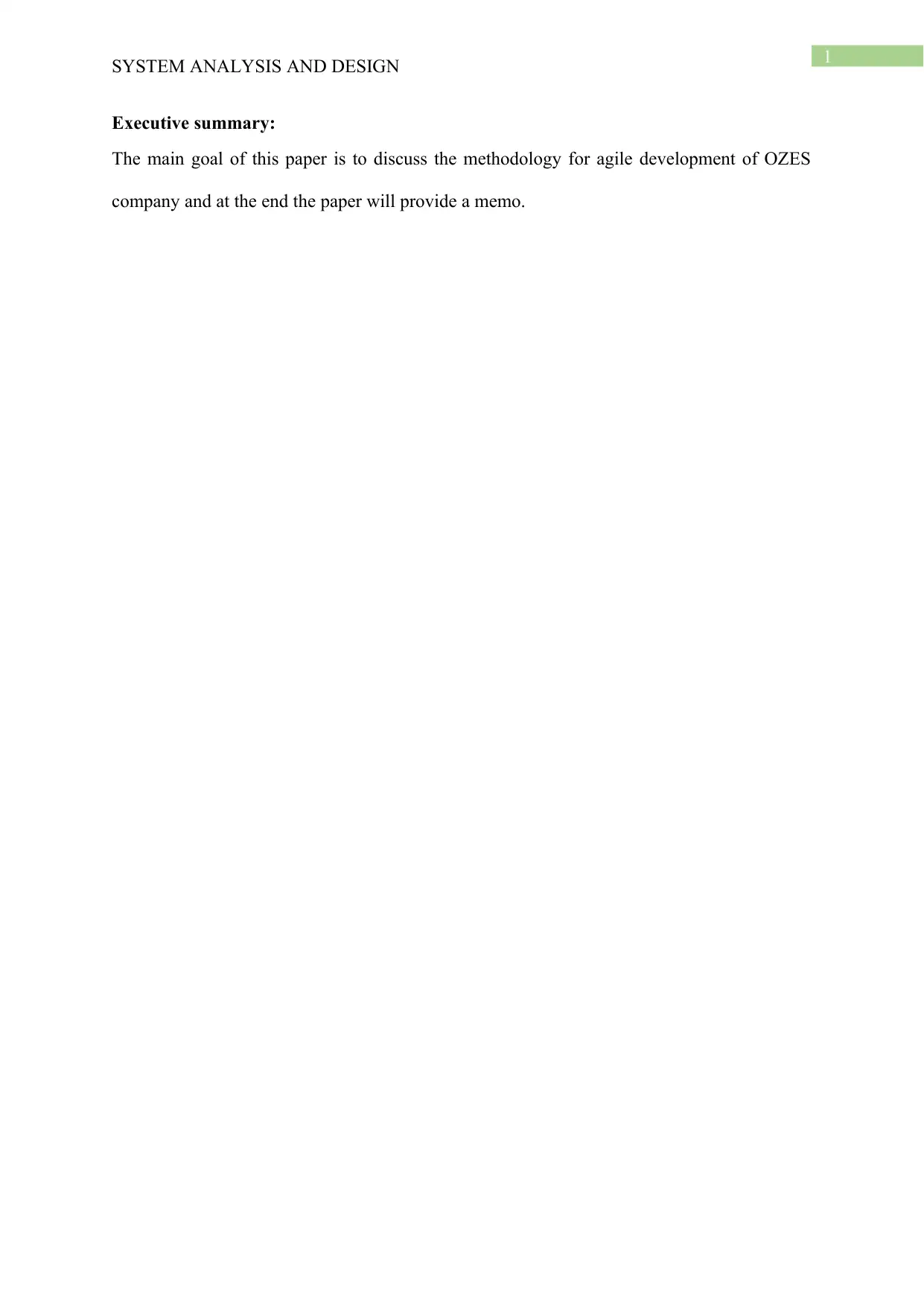
1
SYSTEM ANALYSIS AND DESIGN
Executive summary:
The main goal of this paper is to discuss the methodology for agile development of OZES
company and at the end the paper will provide a memo.
SYSTEM ANALYSIS AND DESIGN
Executive summary:
The main goal of this paper is to discuss the methodology for agile development of OZES
company and at the end the paper will provide a memo.

2
SYSTEM ANALYSIS AND DESIGN
Table of Contents
Methodology:.............................................................................................................................3
Event Table................................................................................................................................6
Use Case Diagram......................................................................................................................7
Use Case Description.................................................................................................................9
Domain Model Class Diagram.................................................................................................10
Design Class Diagram..............................................................................................................11
Bibliography.............................................................................................................................16
SYSTEM ANALYSIS AND DESIGN
Table of Contents
Methodology:.............................................................................................................................3
Event Table................................................................................................................................6
Use Case Diagram......................................................................................................................7
Use Case Description.................................................................................................................9
Domain Model Class Diagram.................................................................................................10
Design Class Diagram..............................................................................................................11
Bibliography.............................................................................................................................16
⊘ This is a preview!⊘
Do you want full access?
Subscribe today to unlock all pages.

Trusted by 1+ million students worldwide
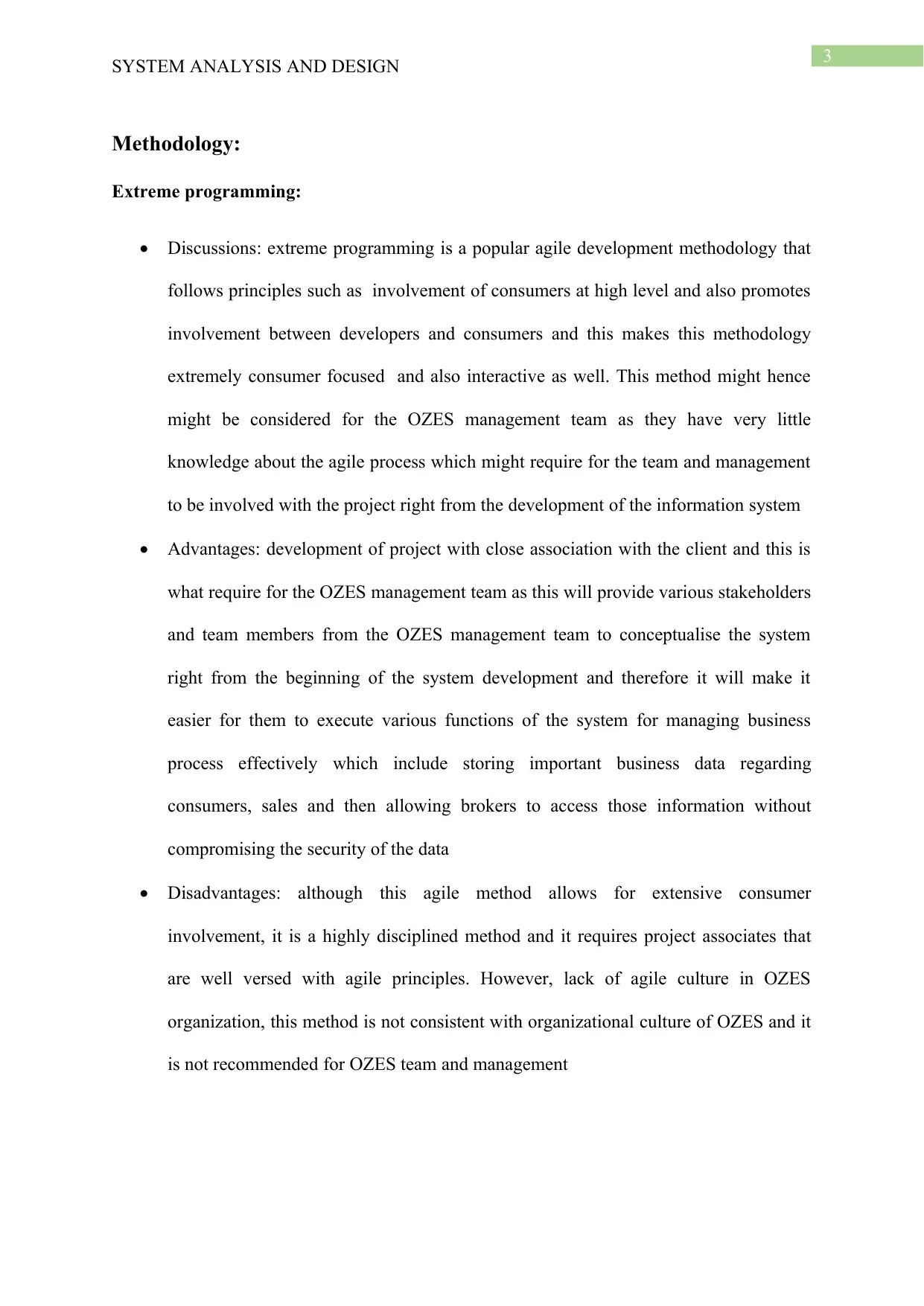
3
SYSTEM ANALYSIS AND DESIGN
Methodology:
Extreme programming:
Discussions: extreme programming is a popular agile development methodology that
follows principles such as involvement of consumers at high level and also promotes
involvement between developers and consumers and this makes this methodology
extremely consumer focused and also interactive as well. This method might hence
might be considered for the OZES management team as they have very little
knowledge about the agile process which might require for the team and management
to be involved with the project right from the development of the information system
Advantages: development of project with close association with the client and this is
what require for the OZES management team as this will provide various stakeholders
and team members from the OZES management team to conceptualise the system
right from the beginning of the system development and therefore it will make it
easier for them to execute various functions of the system for managing business
process effectively which include storing important business data regarding
consumers, sales and then allowing brokers to access those information without
compromising the security of the data
Disadvantages: although this agile method allows for extensive consumer
involvement, it is a highly disciplined method and it requires project associates that
are well versed with agile principles. However, lack of agile culture in OZES
organization, this method is not consistent with organizational culture of OZES and it
is not recommended for OZES team and management
SYSTEM ANALYSIS AND DESIGN
Methodology:
Extreme programming:
Discussions: extreme programming is a popular agile development methodology that
follows principles such as involvement of consumers at high level and also promotes
involvement between developers and consumers and this makes this methodology
extremely consumer focused and also interactive as well. This method might hence
might be considered for the OZES management team as they have very little
knowledge about the agile process which might require for the team and management
to be involved with the project right from the development of the information system
Advantages: development of project with close association with the client and this is
what require for the OZES management team as this will provide various stakeholders
and team members from the OZES management team to conceptualise the system
right from the beginning of the system development and therefore it will make it
easier for them to execute various functions of the system for managing business
process effectively which include storing important business data regarding
consumers, sales and then allowing brokers to access those information without
compromising the security of the data
Disadvantages: although this agile method allows for extensive consumer
involvement, it is a highly disciplined method and it requires project associates that
are well versed with agile principles. However, lack of agile culture in OZES
organization, this method is not consistent with organizational culture of OZES and it
is not recommended for OZES team and management
Paraphrase This Document
Need a fresh take? Get an instant paraphrase of this document with our AI Paraphraser

4
SYSTEM ANALYSIS AND DESIGN
Scrum:
Discussions: this method is most widely used for agile software development. Here in
this method product owner is in control of the project iteration. The developer team
follows the iteration and project is executed in that sequence according to the
prioritization defined by the product owner. Each project iteration is known as sprint
and these sprint are mostly of 30 days duration
Advantages: scrum provides full control to product owner and hence this will allow
OZES to execute the system development according the way they like it to develop
within the duration they want the project to be completed
Disadvantages: if product owner is not well versed with the project development
through agile method, it is most likely that the schedule developed by the team will
not be proper and it might lead to scope creep and project creep which might lead to
overall project delay with increase in project cost. Hence, this method for OZES
might be risky to adopt for developing the information system for their business
process
Lean development:
Discussions: it is a software development methodology in agile software
development where the main focus is optimization of efficiency and minimization
of waste.
Advantages: lean development method simplifies the project development process
and thus helps to reduce various aspects that increases project complexity. Hence,
application of this methodology for developing CRM system is an effective choice
for OZES
SYSTEM ANALYSIS AND DESIGN
Scrum:
Discussions: this method is most widely used for agile software development. Here in
this method product owner is in control of the project iteration. The developer team
follows the iteration and project is executed in that sequence according to the
prioritization defined by the product owner. Each project iteration is known as sprint
and these sprint are mostly of 30 days duration
Advantages: scrum provides full control to product owner and hence this will allow
OZES to execute the system development according the way they like it to develop
within the duration they want the project to be completed
Disadvantages: if product owner is not well versed with the project development
through agile method, it is most likely that the schedule developed by the team will
not be proper and it might lead to scope creep and project creep which might lead to
overall project delay with increase in project cost. Hence, this method for OZES
might be risky to adopt for developing the information system for their business
process
Lean development:
Discussions: it is a software development methodology in agile software
development where the main focus is optimization of efficiency and minimization
of waste.
Advantages: lean development method simplifies the project development process
and thus helps to reduce various aspects that increases project complexity. Hence,
application of this methodology for developing CRM system is an effective choice
for OZES

5
SYSTEM ANALYSIS AND DESIGN
Disadvantages: the project requires extensive involvement of team member and
success of the project depends on each of the team members. However, lean
development allows to outsource project development if organization does not
have required expertise for developing the project and this is the case with OZES
team and this is where lean development methodology is an effective choice for
CRM system development
Adaptive software development:
Discussions: the adaptive system development methodology is one of the popular
agile development methodology and the main principle of this method is faster
development and software evaluation
Advantages: the fast nature of this method allows to develop system with less time
and it integrates evaluation of the software while development of the software is being
executed. Therefore this method is suitable for companies who want faster product
development without compromising in the quality of the software
Disadvantage: agile method provides faster project execution, but the organization
should have proper infrastructure which is consistent with this principle and
organizational culture plays an important role in this context. However, OZES has not
conducted any previous project with agile method and they have not enough
experience in this regard as well therefore it is not suitable for them to develop the
CRM system with this method
Recommendation:
According to this discussion, it is clear that each method has its own advantages and
disadvantages. CRM system development is traditionally complex process and requires
effective project planning with adequate details for each of the strategy deployed for the
SYSTEM ANALYSIS AND DESIGN
Disadvantages: the project requires extensive involvement of team member and
success of the project depends on each of the team members. However, lean
development allows to outsource project development if organization does not
have required expertise for developing the project and this is the case with OZES
team and this is where lean development methodology is an effective choice for
CRM system development
Adaptive software development:
Discussions: the adaptive system development methodology is one of the popular
agile development methodology and the main principle of this method is faster
development and software evaluation
Advantages: the fast nature of this method allows to develop system with less time
and it integrates evaluation of the software while development of the software is being
executed. Therefore this method is suitable for companies who want faster product
development without compromising in the quality of the software
Disadvantage: agile method provides faster project execution, but the organization
should have proper infrastructure which is consistent with this principle and
organizational culture plays an important role in this context. However, OZES has not
conducted any previous project with agile method and they have not enough
experience in this regard as well therefore it is not suitable for them to develop the
CRM system with this method
Recommendation:
According to this discussion, it is clear that each method has its own advantages and
disadvantages. CRM system development is traditionally complex process and requires
effective project planning with adequate details for each of the strategy deployed for the
⊘ This is a preview!⊘
Do you want full access?
Subscribe today to unlock all pages.

Trusted by 1+ million students worldwide

6
SYSTEM ANALYSIS AND DESIGN
project. However, focus should be such that detailing for project planning does not include
information which is not relevant to the project planning and project execution to ensure that
project is not affected with information overflow. In this respect, lean development is an
excellent choice for CRM development.
Event Table
The event table is a table of data that helps the users for storing, retrieving as well as
processing the events within a table database such as the structure. The table is designed for
utilizing the cases where the events are required to be extracted from the stream as well as
accumulated over a huge period for the later batch or the real time processing. In the window
that are predefined, the event table might be having more sophisticated strong as well as the
criteria that is retrieval. An event table may be utilized in the SiddhiQL expressions. The
event table is given below.
Event Trigger Source Use Case Response Destinatio
n
Place
Advertisement
Uploading
Advertisement
Brokers Advertisement Contact Customers
Contact
Organization
Place a phone
call
Customer Make Call Display
Questionnaire
System
Answer the
questionnaire
Submit the
Questionnaire
Customer Provide
Details
Request
reference
information
System
Provide
reference
Advertiser
ID / Reference
ID
Customer Provide
Reference
Store the
Details
System
SYSTEM ANALYSIS AND DESIGN
project. However, focus should be such that detailing for project planning does not include
information which is not relevant to the project planning and project execution to ensure that
project is not affected with information overflow. In this respect, lean development is an
excellent choice for CRM development.
Event Table
The event table is a table of data that helps the users for storing, retrieving as well as
processing the events within a table database such as the structure. The table is designed for
utilizing the cases where the events are required to be extracted from the stream as well as
accumulated over a huge period for the later batch or the real time processing. In the window
that are predefined, the event table might be having more sophisticated strong as well as the
criteria that is retrieval. An event table may be utilized in the SiddhiQL expressions. The
event table is given below.
Event Trigger Source Use Case Response Destinatio
n
Place
Advertisement
Uploading
Advertisement
Brokers Advertisement Contact Customers
Contact
Organization
Place a phone
call
Customer Make Call Display
Questionnaire
System
Answer the
questionnaire
Submit the
Questionnaire
Customer Provide
Details
Request
reference
information
System
Provide
reference
Advertiser
ID / Reference
ID
Customer Provide
Reference
Store the
Details
System
Paraphrase This Document
Need a fresh take? Get an instant paraphrase of this document with our AI Paraphraser
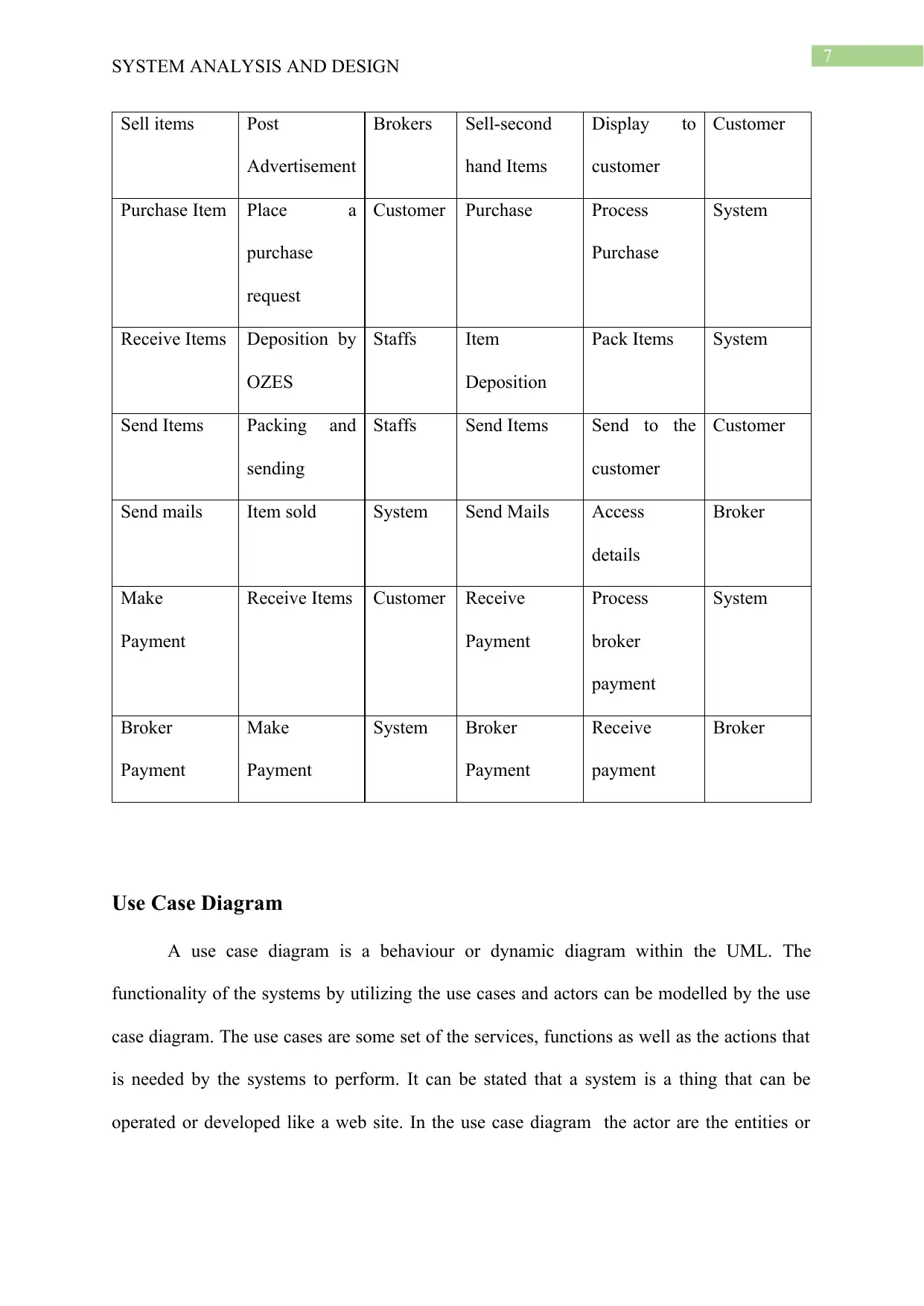
7
SYSTEM ANALYSIS AND DESIGN
Sell items Post
Advertisement
Brokers Sell-second
hand Items
Display to
customer
Customer
Purchase Item Place a
purchase
request
Customer Purchase Process
Purchase
System
Receive Items Deposition by
OZES
Staffs Item
Deposition
Pack Items System
Send Items Packing and
sending
Staffs Send Items Send to the
customer
Customer
Send mails Item sold System Send Mails Access
details
Broker
Make
Payment
Receive Items Customer Receive
Payment
Process
broker
payment
System
Broker
Payment
Make
Payment
System Broker
Payment
Receive
payment
Broker
Use Case Diagram
A use case diagram is a behaviour or dynamic diagram within the UML. The
functionality of the systems by utilizing the use cases and actors can be modelled by the use
case diagram. The use cases are some set of the services, functions as well as the actions that
is needed by the systems to perform. It can be stated that a system is a thing that can be
operated or developed like a web site. In the use case diagram the actor are the entities or
SYSTEM ANALYSIS AND DESIGN
Sell items Post
Advertisement
Brokers Sell-second
hand Items
Display to
customer
Customer
Purchase Item Place a
purchase
request
Customer Purchase Process
Purchase
System
Receive Items Deposition by
OZES
Staffs Item
Deposition
Pack Items System
Send Items Packing and
sending
Staffs Send Items Send to the
customer
Customer
Send mails Item sold System Send Mails Access
details
Broker
Make
Payment
Receive Items Customer Receive
Payment
Process
broker
payment
System
Broker
Payment
Make
Payment
System Broker
Payment
Receive
payment
Broker
Use Case Diagram
A use case diagram is a behaviour or dynamic diagram within the UML. The
functionality of the systems by utilizing the use cases and actors can be modelled by the use
case diagram. The use cases are some set of the services, functions as well as the actions that
is needed by the systems to perform. It can be stated that a system is a thing that can be
operated or developed like a web site. In the use case diagram the actor are the entities or

8
SYSTEM ANALYSIS AND DESIGN
people who have been operating under the roles that are defined in the system. The use case
diagram is as follows:
SYSTEM ANALYSIS AND DESIGN
people who have been operating under the roles that are defined in the system. The use case
diagram is as follows:
⊘ This is a preview!⊘
Do you want full access?
Subscribe today to unlock all pages.

Trusted by 1+ million students worldwide
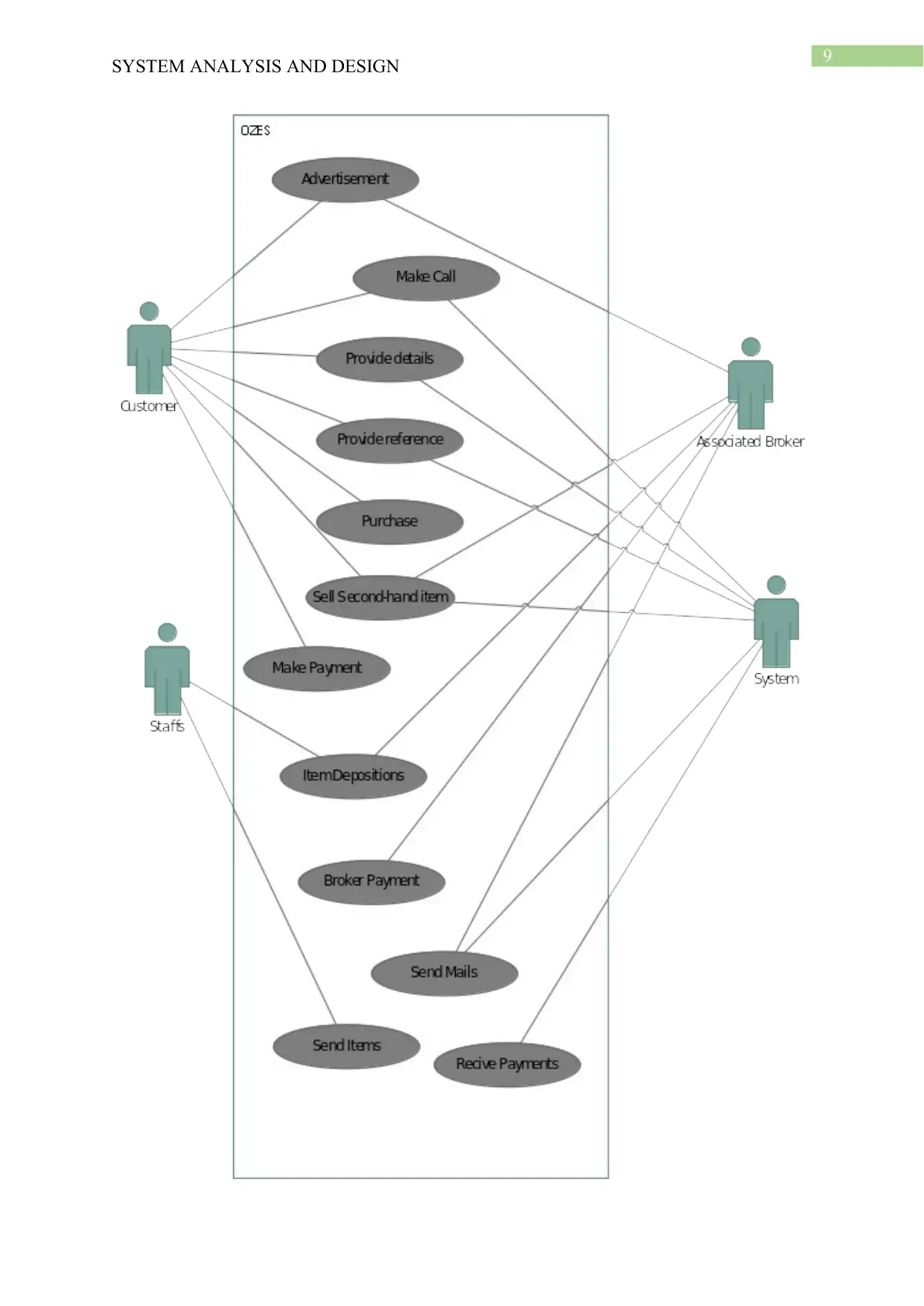
9
SYSTEM ANALYSIS AND DESIGN
SYSTEM ANALYSIS AND DESIGN
Paraphrase This Document
Need a fresh take? Get an instant paraphrase of this document with our AI Paraphraser
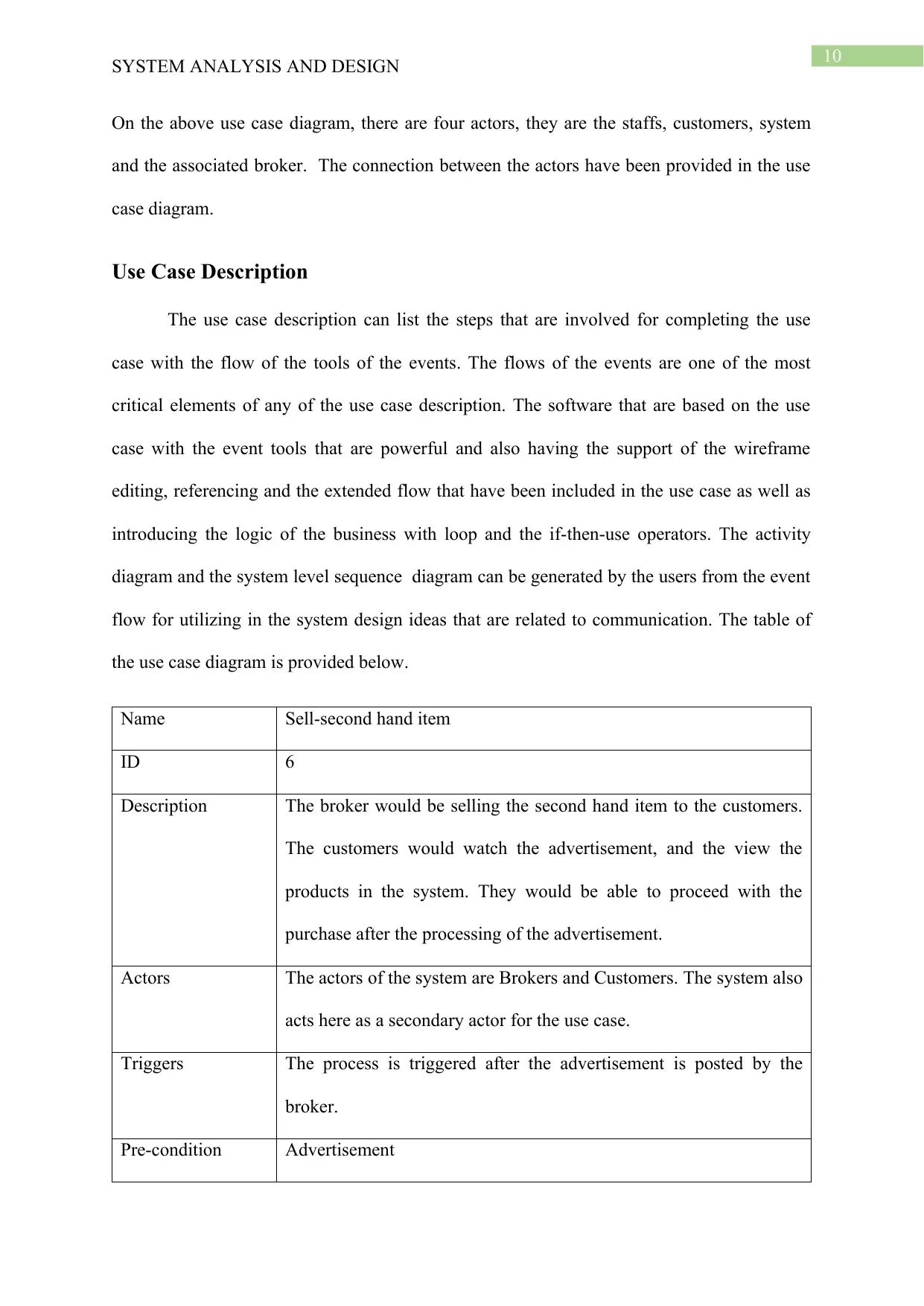
10
SYSTEM ANALYSIS AND DESIGN
On the above use case diagram, there are four actors, they are the staffs, customers, system
and the associated broker. The connection between the actors have been provided in the use
case diagram.
Use Case Description
The use case description can list the steps that are involved for completing the use
case with the flow of the tools of the events. The flows of the events are one of the most
critical elements of any of the use case description. The software that are based on the use
case with the event tools that are powerful and also having the support of the wireframe
editing, referencing and the extended flow that have been included in the use case as well as
introducing the logic of the business with loop and the if-then-use operators. The activity
diagram and the system level sequence diagram can be generated by the users from the event
flow for utilizing in the system design ideas that are related to communication. The table of
the use case diagram is provided below.
Name Sell-second hand item
ID 6
Description The broker would be selling the second hand item to the customers.
The customers would watch the advertisement, and the view the
products in the system. They would be able to proceed with the
purchase after the processing of the advertisement.
Actors The actors of the system are Brokers and Customers. The system also
acts here as a secondary actor for the use case.
Triggers The process is triggered after the advertisement is posted by the
broker.
Pre-condition Advertisement
SYSTEM ANALYSIS AND DESIGN
On the above use case diagram, there are four actors, they are the staffs, customers, system
and the associated broker. The connection between the actors have been provided in the use
case diagram.
Use Case Description
The use case description can list the steps that are involved for completing the use
case with the flow of the tools of the events. The flows of the events are one of the most
critical elements of any of the use case description. The software that are based on the use
case with the event tools that are powerful and also having the support of the wireframe
editing, referencing and the extended flow that have been included in the use case as well as
introducing the logic of the business with loop and the if-then-use operators. The activity
diagram and the system level sequence diagram can be generated by the users from the event
flow for utilizing in the system design ideas that are related to communication. The table of
the use case diagram is provided below.
Name Sell-second hand item
ID 6
Description The broker would be selling the second hand item to the customers.
The customers would watch the advertisement, and the view the
products in the system. They would be able to proceed with the
purchase after the processing of the advertisement.
Actors The actors of the system are Brokers and Customers. The system also
acts here as a secondary actor for the use case.
Triggers The process is triggered after the advertisement is posted by the
broker.
Pre-condition Advertisement
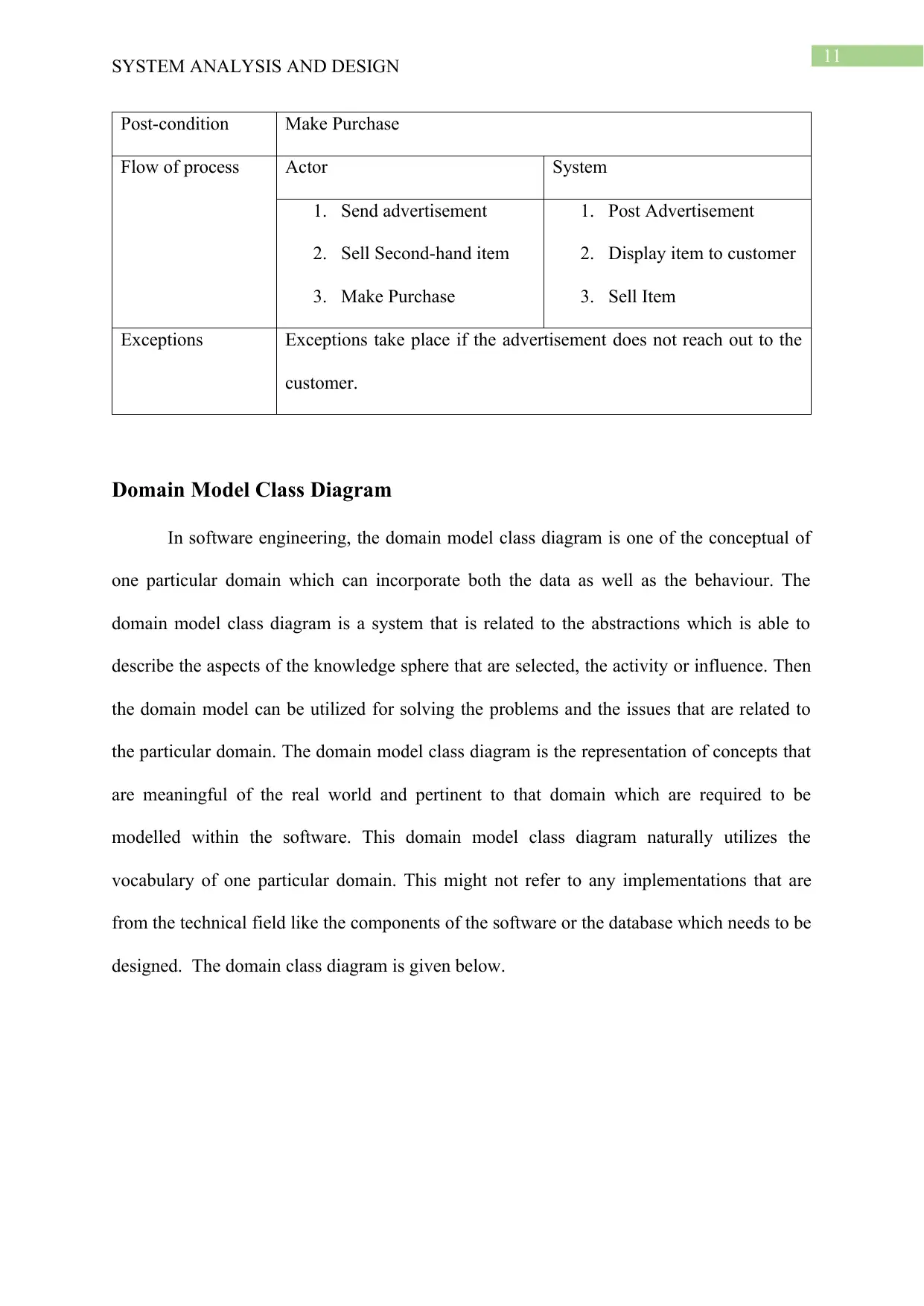
11
SYSTEM ANALYSIS AND DESIGN
Post-condition Make Purchase
Flow of process Actor System
1. Send advertisement
2. Sell Second-hand item
3. Make Purchase
1. Post Advertisement
2. Display item to customer
3. Sell Item
Exceptions Exceptions take place if the advertisement does not reach out to the
customer.
Domain Model Class Diagram
In software engineering, the domain model class diagram is one of the conceptual of
one particular domain which can incorporate both the data as well as the behaviour. The
domain model class diagram is a system that is related to the abstractions which is able to
describe the aspects of the knowledge sphere that are selected, the activity or influence. Then
the domain model can be utilized for solving the problems and the issues that are related to
the particular domain. The domain model class diagram is the representation of concepts that
are meaningful of the real world and pertinent to that domain which are required to be
modelled within the software. This domain model class diagram naturally utilizes the
vocabulary of one particular domain. This might not refer to any implementations that are
from the technical field like the components of the software or the database which needs to be
designed. The domain class diagram is given below.
SYSTEM ANALYSIS AND DESIGN
Post-condition Make Purchase
Flow of process Actor System
1. Send advertisement
2. Sell Second-hand item
3. Make Purchase
1. Post Advertisement
2. Display item to customer
3. Sell Item
Exceptions Exceptions take place if the advertisement does not reach out to the
customer.
Domain Model Class Diagram
In software engineering, the domain model class diagram is one of the conceptual of
one particular domain which can incorporate both the data as well as the behaviour. The
domain model class diagram is a system that is related to the abstractions which is able to
describe the aspects of the knowledge sphere that are selected, the activity or influence. Then
the domain model can be utilized for solving the problems and the issues that are related to
the particular domain. The domain model class diagram is the representation of concepts that
are meaningful of the real world and pertinent to that domain which are required to be
modelled within the software. This domain model class diagram naturally utilizes the
vocabulary of one particular domain. This might not refer to any implementations that are
from the technical field like the components of the software or the database which needs to be
designed. The domain class diagram is given below.
⊘ This is a preview!⊘
Do you want full access?
Subscribe today to unlock all pages.

Trusted by 1+ million students worldwide
1 out of 19
Related Documents
Your All-in-One AI-Powered Toolkit for Academic Success.
+13062052269
info@desklib.com
Available 24*7 on WhatsApp / Email
![[object Object]](/_next/static/media/star-bottom.7253800d.svg)
Unlock your academic potential
Copyright © 2020–2025 A2Z Services. All Rights Reserved. Developed and managed by ZUCOL.




